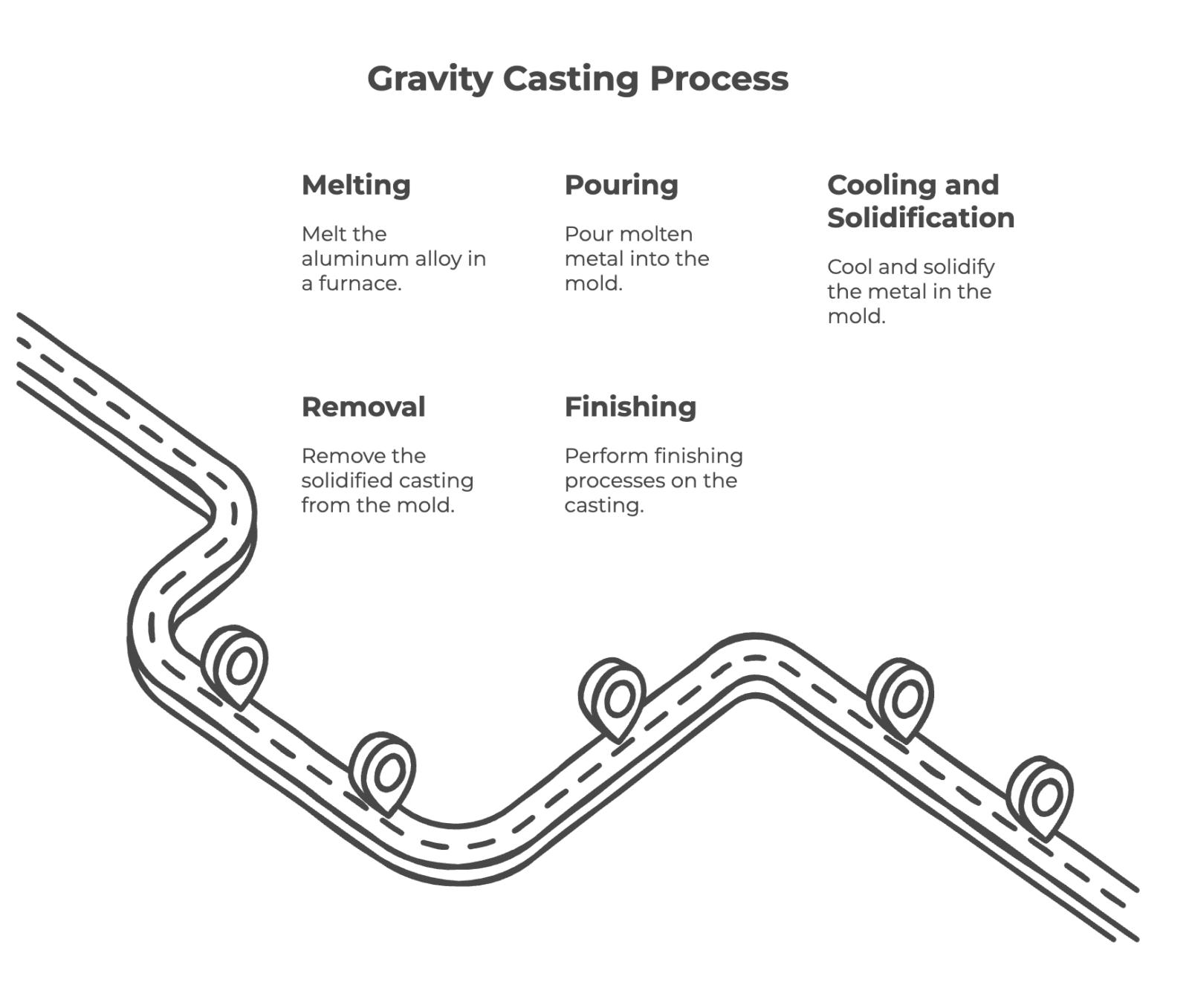◆Table of contents
ToggleIntroduction
There are various types of aluminum casting, and typical examples include sand casting, die casting, and gravity casting.
- Sand Casting: Low initial cost, but low productivity and unsuitable for mass production. Can handle complex shapes.
- Die Casting: High dimensional accuracy and suitable for mass production, but high initial cost and unsuitable for complex shapes.
- Gravity Casting: Uses gravity to pour molten aluminum, resulting in high airtightness, higher quality than sand casting, and lower cost than die casting.
This article focuses on gravity casting and explains its characteristics and contribution to high-mix low-volume production.
Gravity Casting Principles and Processes
Gravity Casting Principle: Utilizing the Gravity of Molten Metal
Gravity casting is a casting method that forms products by pouring molten metal into a mold using its own gravity and allowing it to cool and solidify. Because molten metal is allowed to flow into the mold by natural force without applying pressure, air entrainment is reduced and the occurrence of blowholes (cavities inside the casting) can be suppressed. Also, since molds can be used repeatedly, it is suitable for mass production.
Gravity Casting Process
The gravity casting process consists of the following five main steps.
- Melting: Melt the aluminum alloy in a melting furnace.
- The melting temperature, melting time, and molten metal composition control are important factors that affect the quality of the casting.
- Pouring: Pour the molten metal into the mold.
- The shape, position, and number of the pouring basin (the hole through which molten metal is injected into the mold) and runners (passages that allow molten metal to flow throughout the mold) have a significant impact on the quality of the casting.
- The flow rate and temperature of the molten metal are also important control items to suppress the occurrence of casting defects.
- Cooling and Solidification: Cool and solidify the molten metal in the mold.
- The cooling rate affects the structure and mechanical properties of the casting.
- The cooling rate can be controlled by adjusting the mold material, shape, and cooling method.
- Removal: Remove the solidified casting from the mold.
- The removal method and timing are important to prevent deformation and damage to the casting.
- Finishing: Perform finishing processes such as deburring and surface treatment on the casting.
- Deburring is the process of removing unnecessary protrusions from the casting.
- Surface treatment is performed to improve the corrosion resistance and aesthetics of the casting.
Types of Gravity Casting
There are several types of gravity casting.
| Type of Gravity Casting | Characteristics | Application Examples |
|---|---|---|
| Horizontal Gravity Casting | The most common method of placing the mold horizontally and pouring molten metal | General castings |
| Inclined Gravity Casting | A method of pouring molten metal by tilting the mold to increase the fluidity of the molten metal | Complex shapes and thin-walled castings |
| Automated Gravity Casting | Automates the process using automatic tilting devices and robots | High productivity and stable quality |
- Horizontal Gravity Casting: A method of placing the mold horizontally and pouring molten metal. It is the most common gravity casting method.
- Inclined Gravity Casting: A method of pouring molten metal by tilting the mold to increase the fluidity of the molten metal. Suitable for castings with complex shapes and thin-walled castings.
- Automated Gravity Casting: A method of automating the process from pouring to removal using automatic tilting devices and robots. Contributes to improved productivity and stable quality.
These gravity casting methods are selected according to the product’s shape, size, production volume, quality requirements, and other factors.
Advantages and Disadvantages of Gravity Casting
Gravity casting is a casting method that pours molten metal into a mold using gravity (own weight), and has various advantages and disadvantages. Here, we will explain the main advantages and disadvantages of gravity casting in detail.
Advantages
- High Quality: Few blowholes and excellent mechanical properties
- Dimensional Accuracy/Casting Skin: Good dimensional accuracy and casting skin
- Cost: Lower mold cost than die casting
- Productivity: Molds can be used repeatedly
- High-Mix Low-Volume Production: Can handle complex shapes with cores
Disadvantages
- Initial Cost: Higher mold cost than sand casting
- Productivity: Slower production speed than die casting
- Design Constraints: Not suitable for thin-walled products
- Quality Control: Molten metal management and cooling rate adjustment can be difficult
Gravity casting is selected as the optimal casting method considering these advantages and disadvantages, according to the product’s shape, size, production volume, quality requirements, and other factors.
Products and Applications Suitable for Gravity Casting
Gravity casting is suitable for manufacturing various products due to its characteristics. In particular, gravity casting demonstrates excellent power in the following products and applications.
- Automotive Parts
- Medical Equipment Parts
- Industrial Machinery Parts
- Structural Parts for Home Appliances
- High-Mix Low-Volume Production Items
- Products That Require High Strength and High Airtightness
In addition to the above, gravity casting is used in various fields. It is important to select the optimal casting method considering the product’s shape, size, required quality, production volume, and other factors.
Gravity casting is expected to be used in an increasingly wide range of fields in the future due to its excellent characteristics.
Materials, Molds, and Equipment Used in Gravity Casting
To maximize its characteristics, gravity casting uses appropriate materials, molds, and equipment. The following is a detailed explanation of each.
Materials: Aluminum Alloys (AC4C, AC7A, etc.), Others (Copper Alloys, Cast Iron)
The most commonly used material in gravity casting is aluminum alloy. Aluminum alloys are used in various products because they are lightweight yet strong and have excellent castability.
Typical aluminum alloys include AC4C and AC7A. AC4C has excellent castability, mechanical properties, and corrosion resistance, and is used in a wide range of applications. AC7A is particularly strong and is used for aircraft parts and automobile parts.
In addition, copper alloys and cast iron may be used in gravity casting. Copper alloys have excellent conductivity and corrosion resistance, and are used for electrical parts and piping parts. Cast iron has excellent strength and wear resistance, and is used for machine parts and automobile parts.
Molds: Heat-Resistant Metals (Mold Steel, etc.), Cores
Molds used in gravity casting are made of heat-resistant metal. Generally, a special steel material called mold steel is used. Mold steel can withstand high temperatures and can be used repeatedly.
Molds are precisely machined to match the shape of the product. When manufacturing products with complex shapes, a sand mold called a core is incorporated into the mold. Cores are used to form cavities and complex shapes inside the product.
Equipment: Melting Furnaces, Molds, Automatic Tilting Devices, Cooling Systems
The main equipment used in gravity casting is as follows.
- Melting furnace: Used to melt metals such as aluminum alloys. Electric furnaces and gas furnaces are used.
- Mold: Used to pour molten metal and form the shape of the product.
- Automatic tilting device: Used when tilting the mold and pouring molten metal.
- Cooling system: Used to cool the casting and promote solidification.
In addition to these equipment, various auxiliary equipment may be used to perform casting work efficiently.
The materials, molds, and equipment used in gravity casting are selected according to the product’s shape, size, required quality, production volume, and other factors. High-quality castings can be manufactured efficiently by selecting appropriate materials, molds, and equipment.
Design and Manufacturing Considerations and Quality Control in Gravity Casting
Gravity casting can maximize its potential through proper design and manufacturing processes, and rigorous quality control. Here, we will explain in detail the design considerations and quality control in gravity casting.
Design Considerations
- Design considering mold cooling rate
- Compensation for solidification shrinkage
- Optimization of core placement and pouring basin design
Summary
Gravity casting is a casting method that pours molten metal into a mold using gravity, and is characterized by its ability to achieve low blowholes and high dimensional accuracy. It is suitable for high-mix low-volume production because it is higher quality than sand casting and lower cost than die casting. It is used in a wide range of applications such as automobile parts, medical equipment, and industrial machinery, and is also suitable for products that require high strength and high airtightness. Selection of appropriate materials and equipment is important, and it is a casting technology that is expected to develop further in the future.

